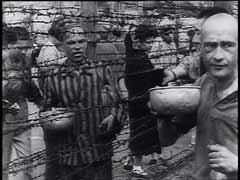You searched for: 数字货币游戏,加密货币游戏,数字币游戏,used博彩游戏,【www.2266.com,复制打开网址】,ust泰达币博彩网站,区块链游戏排名,区块链游戏nft,区块链游戏平台,nft游戏有哪些,nft是什么游戏,以太坊游戏,区块链游戏赚钱网站,币圈游戏,区块链博彩平台,网址kaefhfkccdckbghcd
<< Previous | Displaying results 251-300 of 1782 for "数字货币游戏,加密货币游戏,数字币游戏,used博彩游戏,【www.2266.com,复制打开网址】,ust泰达币博彩网站,区块链游戏排名,区块链游戏nft,区块链游戏平台,nft游戏有哪些,nft是什么游戏,以太坊游戏,区块链游戏赚钱网站,币圈游戏,区块链博彩平台,网址kaefhfkccdckbghcd" | Next >>
-
Insignia of the 90th Infantry Division
PhotoInsignia of the 90th Infantry Division. Called the "Tough Ombres," the 90th Infantry Division was raised from draftees from the states of Texas and Oklahoma during World War I. The divisional insignia incorporates the letters "T" and "O" to symbolize both states. These letters later yielded the nickname "Tough Ombres," symbolizing the esprit de corps of the unit. The 90th was also sometimes called the "Alamo" division during World War II.
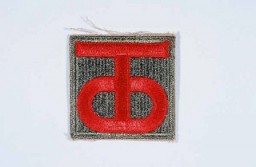
-
Insignia of the 83rd Infantry Division
PhotoInsignia of the 83rd Infantry Division. The 83rd Infantry Division received its nickname, the "Thunderbolt" division, after a division-wide contest for a new nickname held in early 1945. The earlier nickname, "Ohio," was based on the division's insignia (which includes the name "Ohio," where the division was raised during World War I). A new nickname was desired to represent the nationwide origins of the division's personnel during World War II.
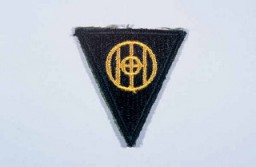
-
Insignia of the 95th Infantry Division
PhotoInsignia of the 95th Infantry Division. The 95th Infantry Division, the "Victory" division, gained its nickname from the divisional insignia approved in 1942: the arabic numeral "9" combined with the roman numeral "V" to represent "95." The "V" led to the nickname, since the letter "V" was universally recognized as an Allied symbol for resistance and victory over the Axis during World War II.
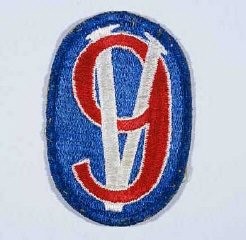
-
Insignia of the 8th Armored Division
PhotoInsignia of the 8th Armored Division. The nickname of the 8th Armored Division, the "Thundering Herd," was coined before the division went to Europe in late 1944. It was also known as the "Iron Snake" late in the war, after a correspondent for Newsweek likened the 8th to a "great ironclad snake" as it crossed the Rhine River in late March 1945.
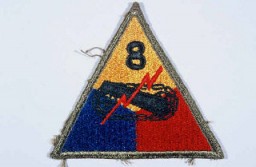
-
Insignia of the 8th Infantry Division
PhotoInsignia of the 8th Infantry Division. The 8th Infantry Division was known as both the "Golden Arrow" and "Pathfinder" division during World War II. Both nicknames originated from the division's insignia, which includes a gold arrow to represent the nineteenth century explorer of California, John Fremont. The division was formed in California in 1918.
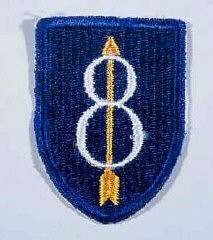
-
Insignia of the 101st Airborne Division
PhotoInsignia of the 101st Airborne Division. The nickname of the 101st Airborne Division, "Screaming Eagles," originates from the division's insignia, a bald eagle on a black shield. "Old Abe" was the eagle mascot of a Wisconsin regiment during the Civil War. The 101st was formed as a reserve unit in Wisconsin shortly after World War I and included "Old Abe" as part of the division's insignia.

-
Insignia of the 103rd Infantry Division
PhotoInsignia of the 103rd Infantry Division. The 103rd Infantry Division, the "Cactus" division, is so called after the 103rd's shoulder patch, a cactus in a gold circle. The cactus is representative of the states whose troops formed the unit in the early 1920s: Arizona, Colorado, and New Mexico.
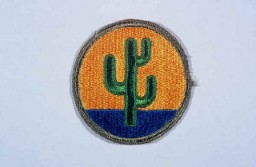
-
Insignia of the 63rd Infantry Division
PhotoInsignia of the 63rd Infantry Division. The 63rd Infantry Division was nicknamed the "Blood and Fire" division soon after its formation in the spring of 1943. The nickname commemorates British prime minister Winston Churchill's statement at the Casablanca Conference in January 1943 that "the enemy would bleed and burn in expiation of their crimes against humanity." The divisional insignia illustrates the nickname.
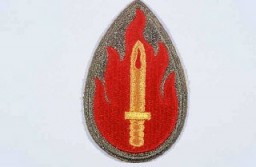
-
Insignia of the 42nd Infantry Division
PhotoInsignia of the 42nd Infantry Division. The nickname of the 42nd Infantry Division, the "Rainbow" division, reflects the composition of the division during World War I. The division was drawn from the National Guards of 26 states and the District of Columbia. It represented a cross section of the American people, as the rainbow represents a cross section of colors.
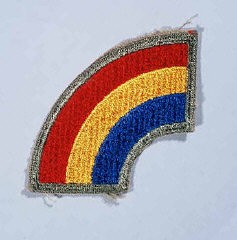
-
Insignia of the 36th Infantry Division
PhotoInsignia of the 36th Infantry Division. The 36th Infantry Division, the "Texas" division, was raised from National Guard units from Texas and Oklahoma during World War I. The "T" in the division's insignia represents Texas, the arrowhead Oklahoma. The division was also sometimes called the "Lone Star" division, again symbolizing its Texas roots.
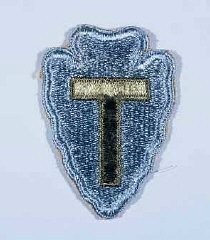
-
Insignia of the 29th Infantry Division
PhotoInsignia of the 29th Infantry Division. "Blue and Gray" was coined as the nickname of the 29th Infantry Division by the division's commander during World War I. The name commemorates the lineage of the mid-Atlantic states' National Guard units that formed the division, many with service on both sides during the Civil War.
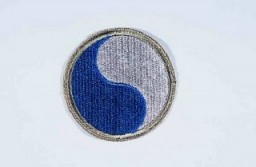
-
Death march victims
PhotoAn American soldier looks at the corpses of Polish, Russian, and Hungarian Jews found in the woods near Neunburg vorm Wald. The victims were prisoners from Flossenbürg who were shot near Neunburg while on a death march. Germany, April 29, 1945.
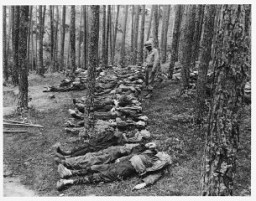
-
Insignia of the 89th Infantry Division
PhotoInsignia of the 89th Infantry Division. The 89th Infantry Division's nickname, the "Rolling W," is based on the division's insignia. Created during World War I, this insignia utilized a letter "M" inside a wheel. When the wheel turns, the "M" becomes a "W." The letters "MW" signify the mid-west origin of the troops who formed the 89th during World War I. The division was also known as the "Middle West" division, another variation on its origin.
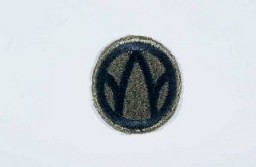
-
Insignia of the 99th Infantry Division
PhotoInsignia of the 99th Infantry Division. The 99th Infantry Division, the "Checkerboard" division, gained its nickname from the division's insignia. The insignia was devised upon the 99th's formation in 1942, when the division was headquartered in the city of Pittsburgh. The blue and white checkerboard in the division's insignia is taken from the coat of arms of William Pitt, for whom Pittsburgh is named. The division was also known as the "Battle Babies" during 1945, a sobriquet coined by a United Press…
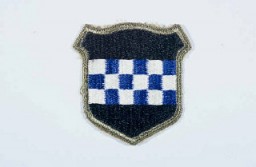
-
Funeral for victims of Wöbbelin
PhotoAfter the liberation of the Wöbbelin camp, US troops forced the townspeople of Ludwigslust to bury the bodies of prisoners killed in the camp. This photo shows US troops assembled at the mass funeral in Ludwigslust. Germany, May 7, 1945.
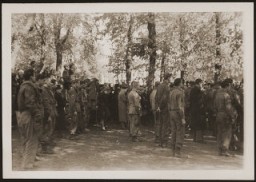
-
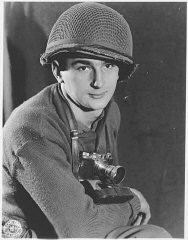
-
Providing aid to refugees
PhotoUS Army and Joint Distribution Committee (JDC) representatives distribute milk to refugees. Vienna, Austria, October 26, 1945.
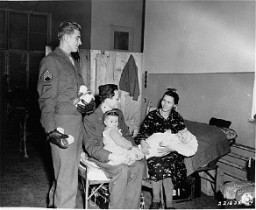
-
Eisenhower tours the Ohrdruf camp
PhotoDuring an official tour of the newly liberated Ohrdruf concentration camp, an Austrian Jewish survivor describes to General Dwight Eisenhower and the members of his entourage the use of the gallows in the camp. Among those pictured is Jules Grad, correspondent for the US Army newspaper Stars and Stripes (on the right). Ohrdruf, Germany, April 12, 1945.
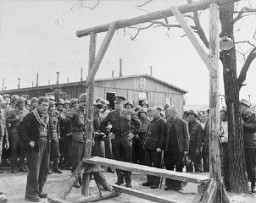
-
Liberated prisoners at the Ebensee camp
PhotoLiberated prisoners at the Ebensee camp. Too weak to eat solid food, they drink a thin soup prepared for them by the US Army. Photograph taken by US Army Signal Corps photographer J Malan Heslop. Austria, May 8, 1945.
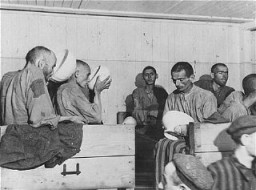
-
Nazi atrocities discovered upon the liberation of Buchenwald
FilmUS forces liberated the Buchenwald concentration camp on April 11, 1945. This footage records examples of Nazi atrocities (shrunken head, pieces of tattooed human skin, preserved skull and organs) discovered by the liberating troops.
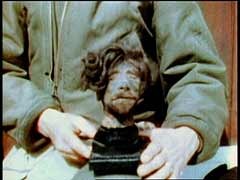
-
Chaplains inspect the liberated Buchenwald camp
PhotoDuring an inspection by US Army chaplains of the newly liberated Buchenwald concentration camp, G. Bromley Oxnam (right) views a demonstration of how prisoners were tortured in Buchenwald. Oxnam was the Methodist bishop of New York and President of the Federated Council of Churches of Christ in America. Buchenwald, Germany, April 27, 1945.
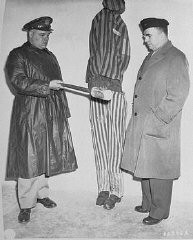
-
Liberated Soviet and Polish prisoners at Mauthausen
PhotoSoviet and Polish prisoners with disabilities stand in front of a tank of the 11th Armored Division, US Third Army. This photograph was taken at the Mauthausen concentration camp immediately after liberation. Austria, May 5–7, 1945.
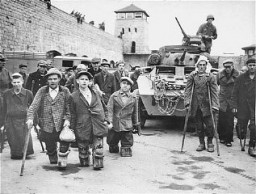
-
Survivors in Langenstein
PhotoSurvivors in Langenstein after the camp was liberated by the 83rd Infantry Division. Langenstein, Germany, April 17, 1945.
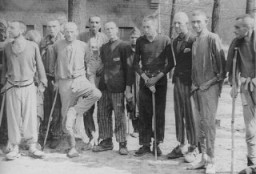
-
Mauthausen camp after liberation
PhotoMauthausen concentration camp inmates with American troops after the liberation of the camp.
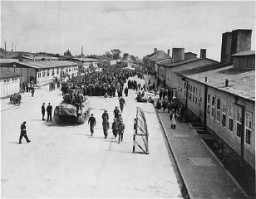
-
A witness at the Mauthausen trial
PhotoA witness testifies during the Mauthausen concentration camp trial. The man standing in the background is defendant Willy Eckert, a member of the SS. The trial took place before an American Military Tribunal in Dachau, Germany. March-May 1936.
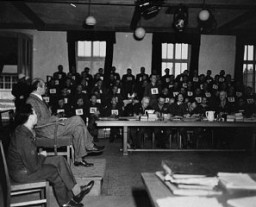
-
Providing medical care to a survivor in Penig
PhotoLt. Col. J.W. Branch, Chief Surgeon of the 6th Armored Division, provides medical care to a Hungarian survivor in Penig, a subcamp of Buchenwald. Penig, Germany, April 26, 1945.
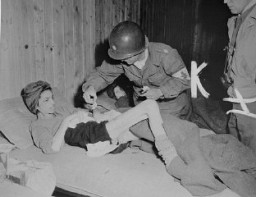
-
Site of the Gardelegen atrocity
PhotoAmerican troops inspect the site of the Gardelegen atrocity. In the background, German civilians exhume corpses who were buried in a mass grave by the SS. Germany, April 18, 1945.

-
An American soldier stands guard in front of the Hadamar Institute
PhotoAn American soldier stands guard in front of the Hadamar Institute. The photograph was taken by an American military photographer soon after the liberation. Germany, April 5, 1945.
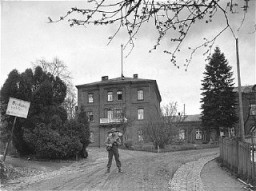
-
Liberator Vernon Tott
PhotoLiberator Vernon Tott (second from left) of the 84th Infantry was honored by some of the survivors he helped free from the Ahlem labor camp near Hanover, Germany. Tott's name was engraved on the Museum's Donor's Lounge wall with the inscription: "In honor of Vernon W. Tott, my liberator & hero." The ceremony in which Tott's name was unveiled came as a complete surprise to him. Washington, DC, November 2003.

-
Body of a prisoner shot by the SS during a death march
PhotoAn American medic and soldier stand by the corpse of a prisoner shot on the road near Gardelegen. The prisoner was shot by the SS when he was too exhausted to continue on a death march. Germany, April 14-18, 1945.
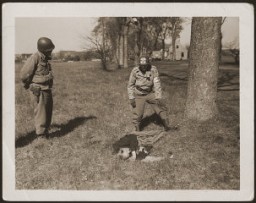
-
Experiences of Black People during the Holocaust and World War II
SeriesLearn about the experiences of Black people during the Holocaust and WWII, including persecution in Nazi Germany, the impact of Nazi ideology, the impact of racism on African American athletes, and the experiences of Black American soldiers.
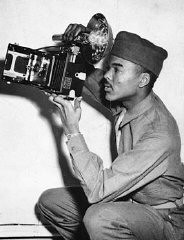
-
Liberation of Dora-Mittelbau
FilmUS forces liberated the Dora-Mittelbau (Nordhausen) concentration camp in April 1945. Here, medics and soldiers of the US 3rd Armored Division evacuate sick and dying survivors of the camp.
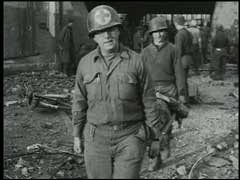
-
Wöbbelin
Media EssayWöbbelin was a subcamp of the Neuengamme concentration camp. When US troops entered Wöbbelin on May 8, 1945, they encountered the horrific conditions that prisoners had faced.
-
Victims of Kaufering IV
PhotoUS troops view bodies of victims of Kaufering IV, a Dachau subcamp in the Landsberg-Kaufering area. Germany, April 30, 1945.

-
Surrendered Germans in Austria
PhotoSurrendered Germans in Austria. May 1945. US Army Signal Corps photograph taken by J Malan Heslop.
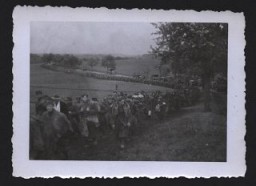
-
Liberation of Dachau
FilmThe Dachau concentration camp, northwest of Munich, Germany, was the first regular concentration camp the Nazis established in 1933. About twelve years later, on April 29, 1945, US armed forces liberated the camp. There were about 30,000 starving prisoners in the camp at the time. Here, soldiers of the US Seventh Army document conditions in the camp. They also require German civilians to tour the camp and confront Nazi atrocities.
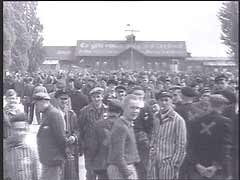
-
German civilians forced to view atrocities committed in Buchenwald
FilmUS forces liberated the Buchenwald concentration camp in Germany in April 1945. Here, US soldiers escort German civilians from the nearby town of Weimar through the Buchenwald camp. The American liberating troops had a policy of forcing German civilians to view the atrocities committed in the camps.

-
Burying the victims of Wöbbelin
PhotoAfter the liberation of the Wöbbelin camp, US troops forced the townspeople of Ludwigslust to bury the bodies of prisoners killed in the camp. This photograph shows German civilians who were ordered to bury the dead; US troops stand in the background. Germany, May 7, 1945
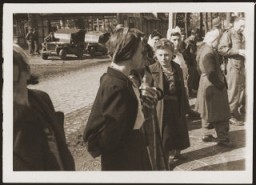
-
Captured German soldiers remove bodies from a barracks in Gunskirchen
PhotoMedical corpsmen of the US 71st Infantry Division, 3rd US Army look on as captured German soldiers remove bodies from inside a barracks in Gunskirchen. In the foreground, a Jewish girl lies huddled in the straw on the floor of the barracks. Gunskirchen, Austria, May 7, 1945.
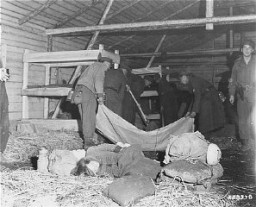
-
Liberation of Buchenwald
FilmThe US army filmed the weak and emaciated survivors of the Buchenwald concentration camp in Germany to document Nazi crimes against humanity. This film was shot shortly after the liberation of the camp in April 1945.
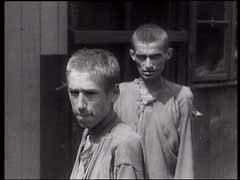
-
Captured Ludendorff bridge
PhotoThe sign erected by the 9th Armored division on the Ludendorff bridge after its capture. March 11, 1945. US Army Signal Corps photograph taken by W. Spangle.
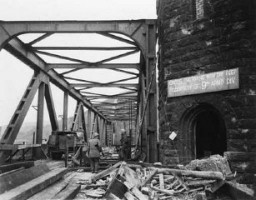
-
Burial of victims killed at the Wöbbelin camp
PhotoAfter the liberation of the Wöbbelin camp, US troops forced the townspeople of Ludwigslust to bury the bodies of prisoners killed in the camp. Germany, May 7, 1945.
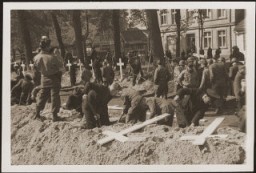
-
Funeral for victims of Wöbbelin
PhotoAfter the liberation of the Wöbbelin camp, US troops forced the townspeople of Ludwigslust to bury the bodies of prisoners killed in the camp and give the victims a proper burial. This photograph shows the funeral for the victims. Germany, May 7, 1945.
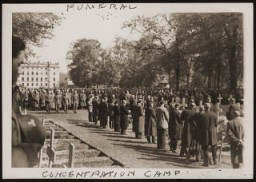
-
Aiding a survivor at Dora-Mittelbau
PhotoA US soldier tends to a former prisoner lying among corpses of victims at the Dora-Mittelbau concentration camp, near Nordhausen. Germany, after April 10, 1945.
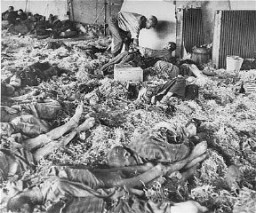
-
Crematorium oven in Flossenbürg
PhotoAfter the liberation of the Flossenbürg camp, a US Army officer (right) examines a crematorium oven in which Flossenbürg camp victims were cremated. Flossenbürg, Germany, April 30, 1945.
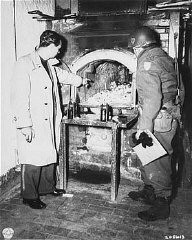
-
Fighting in the Hürtgen Forest
PhotoMortar men of the 754th Tank Battalion fire an 81mm mortar at German positions during the heavy fighting in the Hürtgen Forest. December 15, 1944. US Army Signal Corps photograph taken by C. Tesser.
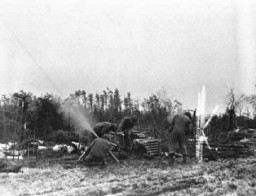
-
Wedding rings
PhotoWedding rings taken from prisoners. The rings were found near the Buchenwald concentration camp following liberation by US Army soldiers. Germany, May 1945.
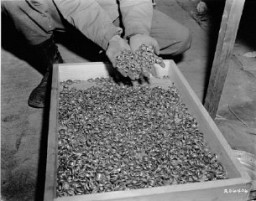
-
Shoes belonging to victims of Flossenbürg
PhotoAfter the liberation of the Flossenbürg concentration camp, two US army infantrymen examine a pile of shoes belonging to victims of the camp. Flossenbürg, Germany, May 1945.

-
Courtroom during the Dachau trial
PhotoView of the courtroom during the Dachau concentration camp trial. November 15-December 13, 1945.
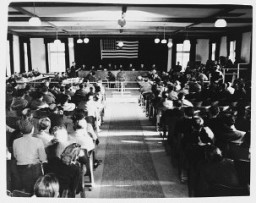
-
Liberation of Mauthausen
FilmThe Mauthausen concentration camp was established shortly after the German annexation of Austria (1938). Prisoners in the camp were forced to perform crushing labor in a nearby stone quarry and, later, to construct subterranean tunnels for rocket assembly factories. US forces liberated the camp in May 1945. In this footage, starving survivors of the Mauthausen concentration camp eat soup and scramble for potatoes.
